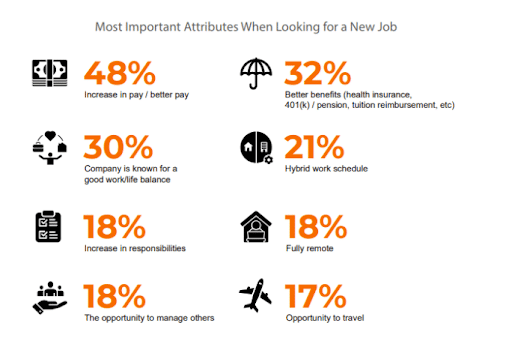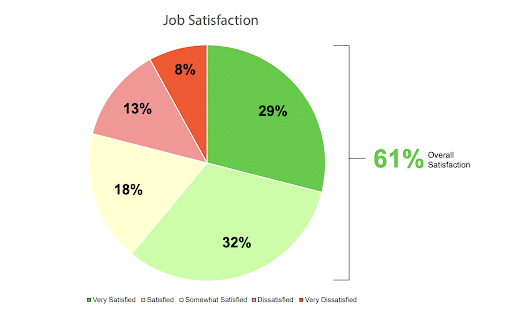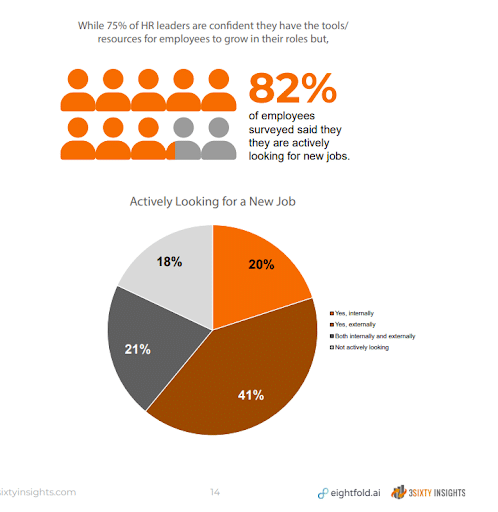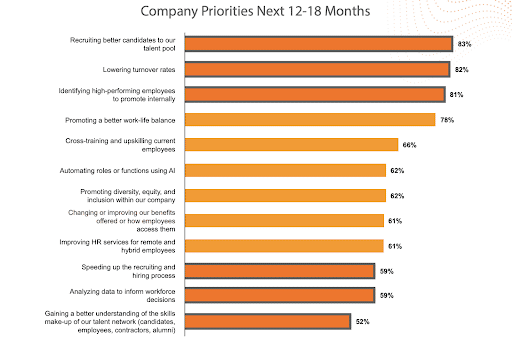- Deloitte’s 2025 Human Global Human Capital Trends report found that in the face of rising instability, organizations need to find “anchors” to help their employees adapt and thrive. They report that two-thirds of workers globally are feeling “overwhelmed” by the fast-paced changes in work, with 49% worried they’ll be left behind.
- In our latest talent survey, we found a similar sense of unease and dissatisfaction among employees. Only 61% of workers are satisfied with their current roles, and 82% of employees reported looking for a job in the past 12-18 months.
- We both found that there’s a clear disconnect between HR and business strategy, in turn affecting employee satisfaction, retention, and development. To retain top-performing talent, you need to address employee challenges, including compensation, lack of internal mobility, and fear of layoffs.
These days stability seems to be in short supply. With rising global uncertainties and rapid advancements in technology like AI, adapting to changes — let alone surviving — is stressing your workers out.
Deloitte’s latest Global Human Capital Trends report includes a large focus on creating stability in your organization to weather these changes. Calling this “stagility,” it’s about creating a stable place for your employees to learn, adapt, grow, and thrive despite the uncertainty.
A call for increased stability should come as no surprise for talent and business leaders in today’s working climate. Two-thirds of global workers report that they feel overwhelmed by all the changes, with 49% fearing that the pace of change will leave them behind.
With 75% of workers craving more stability at work, their bosses are taking note with 85% of business executives saying that they need to create more agile ways of working to adapt quickly to changes.
While leadership prepares for more change, worker concerns about the unknown are increasing. And while most organizations, 72%, say they know they need to balance agility and stability, only 39% are doing something about it.
In our latest talent survey, we asked employees about the greatest challenges they face today — and what organizations could do to assuage their concerns. Here are the 6 top areas of concern for employees and advice on how to address them.
Related content: According to our Annual Talent Survey, 8 out of 10 employees have looked for new jobs in the last year, making recruiter roles even more challenging.
1. Underpaid and undervalued
No surprise, but compensation is always a top consideration for employees with 48% saying an increase in pay is their top motivation to look for a new role. They also report not receiving raises despite taking on more responsibilities. Finally, 32% expect better benefits including health plans and retirement options.
Here are the top reasons why employees are looking for new jobs:

Source: “HR Misalignment Costs You More Than You Think – Here’s Why It Matters”
Constant churn isn’t just a setback — it’s a setup for failure and high expenses, including the intangible costs of lost institutional knowledge and shattered team dynamics. External hiring is about 20% more expensive than hiring internally.
You can solve these challenges by:
- Ensuring pay is competitive and equitable. Given that women working full time in the United States earn an average of 83% of what men earn, regular pay reviews and raises tied to increased responsibilities can help improve employee satisfaction and pay equity.
- Monitoring employees’ needs to personalize benefits packages. With the rising cost of private medical insurance, benefits policies should meet employees’ specific needs.
- Aligning other benefits to your workers’ needs. Benefits packages aren’t one-size-fits-all. Take the time to figure out what is most important — and impactful — in fostering a healthy, thriving workforce and pursue those benefits.
2. Bad bosses, toxic workplaces
Many employees expressed job dissatisfaction due to management and workload issues. In our survey of 1,200 employees, many cited a toxic work culture, specifically unsupportive, negligent, or incompetent managers. In addition, micromanagement, bullying, and a lack of respect were frequent issues, leaving employees feeling ignored and undervalued.
Only 61% of employees are satisfied with their current workplaces.

Source: “HR Misalignment Costs You More Than You Think – Here’s Why It Matters”
Managers must be equipped with the right skills to create a work culture where employees feel safe, respected, and included.
Leadership training can help managers communicate better, galvanize their employees, and address concerns early before issues escalate. When employees see that their leaders care about their growth, they become more invested in the organization’s success.
Research backs this up, showing that top performers are 800% more productive than their peers, proving just how much great leadership can turn a toxic environment around.
3. All work, no balance
In our survey, employees often mentioned being overworked and taking on responsibilities meant for multiple people. Limited flexibility in work schedules and the constant push/pull to answer emails after hours made it even tougher to balance work and personal life.
One of the biggest issues is that many organizations are cutting costs to stay profitable, laying off some employees while asking others to do more. With 45% of managers anticipating layoffs in 2025, it’s vital to find better ways to manage workloads and reduce stress.
To become a true driver of engagement and retention, you should prioritize workload management, flexible work options, and initiatives that align with your organization’s overall strategy by:
- Offering flexible and remote working. Return to office mandates are all the rage, but employees still seek flexibility in where they work. Hybrid working ranked fourth on the list of priorities employees wanted when looking for a new job.
- Regularly reviewing workload distributions to ensure tasks are manageable. Tasks that seem quick to complete may take longer than expected. Recurrent reality checks on workloads and expectations should be the norm.
- Checking in with employees to better understand work-life balance. Encourage senior leaders to model healthy working practices by setting clear boundaries, taking breaks, and respecting employees’ personal time.
4. Climbing a ladder with no rungs
Our report revealed that 53% of dissatisfied employees don’t think their leaders support internal career growth, and 47% don’t believe their organization promotes internal mobility. This explains why 25% of employees said a lack of career development was one of their top reasons for leaving.
Despite these stats, 81% of HR leaders reported that one of their top priorities was identifying high-performing employees to promote, and 82% said they wanted to lower turnover rates.
Yet, our data shows a lack of effort is pushing employees away — and workers are giving up trying to climb a ladder with no rungs.
The disconnect is happening in the execution phase. While 75% of HR leaders said they have the tools and resources for employees to grow in their roles, it seems they lack the right strategies or support systems to execute effective internal mobility programs.

Source: “HR Misalignment Costs You More Than You Think – Here’s Why It Matters”
To address this, make sure you standardize career development conversations. When employees feel heard regarding their learning and development goals, they’re more productive, energized, and engaged.
Career development conversations can also provide the clarity and guidance employees need to bridge the gap between their aspirations and your organization’s goals.
5. Misalignment is messy
We found that over half (52%) of HR leaders aren’t regularly included in high-level discussions with top execs. This misalignment disrupts workforce stability and damages your brand’s reputation.
Plus, it makes attracting and retaining top talent even tougher.
Only 44% of organizations have full alignment between talent strategy and business objectives, leaving the majority in the “misaligned” category. This misalignment can affect everything from hiring and workforce development to organizational performance and profit.

Source: “HR Misalignment Costs You More Than You Think – Here’s Why It Matters”
Employees also expressed frustration with poor communication and slow decision-making. They feel that profit comes before their well-being.
Without leadership support for internal mobility, employees feel undervalued, which drives turnover and creates a negative culture. Meanwhile, weak communication with the C-suite leaves you struggling to plan for your organization’s future talent needs.
To change this, you need a seat at the leadership table. Your HR priorities must align with your business strategies, including employee satisfaction and retention.
6. The constant fear of layoffs
Picture this: you’re an HR leader who believes you’re doing everything possible to support employee growth. You’re working hard, offering mentoring programs, and recognizing achievements.
Yet staffing challenges persist. Despite all the effort, there’s a gap between intent and outcome.
One of the biggest culprits is fear.
Recent examples include the deluge of tech layoffs — and now federal employee layoffs — we’re encountering. Watching large numbers of employees being swept aside in mass layoffs does not instill confidence in anyone.
Organizations that are more strategic when it comes to hiring and firing — especially if they do it through a skills-based lens — are generally more stable workplaces and have more confident employees.
In fact, HR leaders told us that their top priorities were building stronger talent pipelines with external and internal candidates and reducing turnover.

Source: “HR Misalignment Costs You More Than You Think – Here’s Why It Matters”
So, what can you do to ease employees’ fears about job instability? Be transparent.
If your organization is restructuring, it is important to explain how these changes align with business goals and what they mean for employees’ roles. Assessing their skills’ profiles to see where they could be re-deployed, instead of let go, is even better.
In addition, AI is increasingly stoking fears of job displacement. Be open and honest about AI’s role in your workplace, and clarify how AI will complement your employees’ work, not replace them.
See how talent intelligence can help you make better skills-based workforce decisions today.
